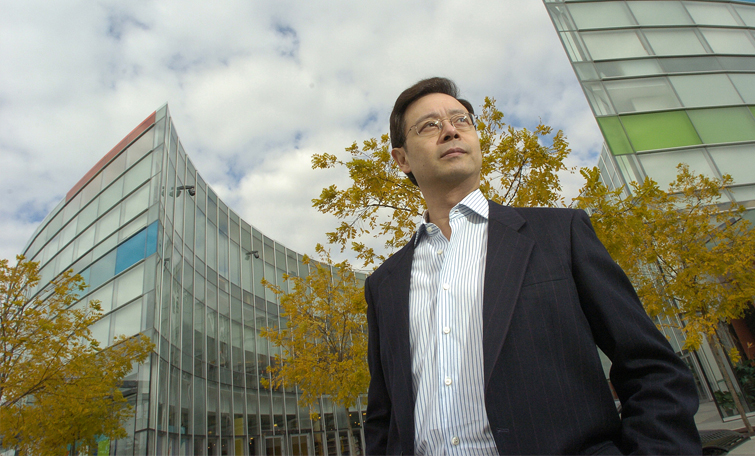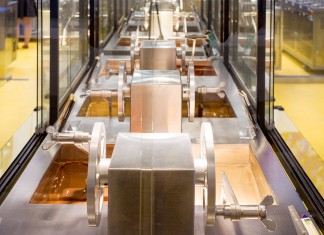Robotics – Now and into the Future
- Caifu Magazine | by Caifu Global
- EN
The idea that we could create a mechanical being in our image, to do our bidding has been the stuff of fiction for generations. In recent years, advances in electrical engineering and the size and speed of micro processors has moved robotics from the realm of science fiction to medical, industrial and consumer applications.
Jim Little, a professor at the University of British Columbia’s computer science/electrical engineering lab says there is a lot of research focus on robotics on human interaction.
“Increasingly we’re going to see robots in the home in a caregiver position, so a connection to humans is becoming more important.”
Little says that the reality versus perception of robots can be skewed by science fiction. Not all robotics involve bipedal humanoid forms. His department, for example is developing an intelligent wheelchair, which of course could have huge benefits for the disabled. “I’m not convinced we need something as big as a free standing bipedal robot,” said Little, admitting that at this stage in robotics development it’s very up in the air how the industry will play out in terms of robot forms.
“If you’re going to have a robot in your home then yes an easy solution is to have one that can walk up and down stairs – that’s one school of thought, that there will be this general purpose robot. But to accommodate a power source for that type of model they would have to be big and fairly clunky, at least in the foreseeable future.”
Little says that the alternative to that are lots of smaller, very specialized robots, or robotic devices.
However Japan, which Little acknowledges is a leader in developing robot technology, leans very strongly towards the humanoid type of robot. “They are big on developing these strange, human-like robots,” says Little, adding that the Japanese are clearly more accepting of robots as part of everyday life, especially as caregivers.
Elizabeth Croft, also of the UBC robotics lab, who specializes in human/robot interfaces, agrees that there is a cultural element to robot design.
“In North America you’re better off with a less humanoid looking robot, more WALL-E or R2D2 than Data,” laughs Croft, referring to popular fiction characters. WALL-E being a crude robot depicted in the 2008 Pixar film and R2D2 being of course from the Star Wars films. Data is the name of the android type robot from the Star Trek TV series. Her comments illustrate how much of our reference to robotics comes from the world of science fiction and as a result we may have preconceived ideas of robotic abilities.
“The reality is we are creating more and more complex, humanoid-like robots but they still need to deliver on the promise,” says Croft. “The Japanese public is very accepting of the android type robot. The challenge with that is if you make it look like it has capacity that it doesn’t then people lose interest very fast.”
Like Little, she explains that for these types of freestanding robots, power sources remain a big challenge.
“Circuits have gotten more dense and they can run for 15-20 minutes instead of five, but that [power source] is a key problem still to be solved.”
But, as Little noted, perhaps the future isn’t in bipedal, humanoid type robots. Already great advances have been made in medical sciences with robotic arms to assist with surgeries, a field that has also been advanced through UBC research, not to mention Carnegie Mellon University in the U.S. Other research includes therapy robotics to assist people in physiotherapy exercises. As well as standing assistant robotics, again to help the disabled, mainly those suffering from balance problems after a stroke.
Then there are military applications.
“The military is very keen on those bipedal forms of robots,” says Little. Although based on the recent U.S Department of Defense’s DARPA (Department Advanced Research Projects Agency) robotic challenge, those types of robots are very much in the early stages of development. However, robotics technology can be adopted much earlier in a hybrid form, as Little notes, “The U.S military is very close to deploying an exo-skeleton that would allow soldiers to carry much heaver loads of equipment over difficult terrain.”
Of course outside of the laboratory, robotics have long been used in industrial/commercial applications, and those applications are increasing all the time, along with the frequency of human/robotic interaction.
Fellow Robots, based in Silicon Valley, California’s legendary tech hub, has developed some of the most successful independent robotic systems. As CEO and founder of Fellow Robots Marcus Mascorro explains, Fellow Robots was first developed in the tech accelerator, Singularity University (also based in Silicon Valley) which provides resources for tech development for start-ups, corporate entities, and institutions.
“[From there] we were connected with [retailer] Lowe’s Innovation Lab. We quickly realized that there was a great deal of synergy between what Lowe’s was looking for and the kind of robot we saw as providing value to the offline retail world.” Like researchers in the academic world, Mascorro says popular imagination, fueled by generations of sci-fi images has created certain expectations.
“Science fiction is a motivating force for many roboticists, but at the end of the day popular sci-fi sets an unrealistic expectation of robot capabilities with most users. And our biggest challenge is dealing with those unrealistic expectations based on fictional characters.” Although Mascorro adds that consumers’ expectations with robotics through fiction can also be a benefit. “Consumers’ familiarity with robot characters makes for easy comparisons. Describing OSHbot as more C-3PO than Rosie (the maid robot from the Jetsons) helps our customers and their consumers better understand OSHbot’s current capabilities.”
OSHbot being Fellow Robot’s latest robot, one designed to work directly with consumers.
Mascorro describes their creations as, “primarily a highly-customized inventory search engine, combined with mobility, telepresence, analytics and translation capabilities.”
That’s to say OSHbot is not just a glorified automated sale’s assistant, it has many applications it can be adapted to.
Fellow Robots are among one of the newer robotics companies creating robots with more flexible applications, rather than a needs-based approach (for example, an automated arm on an assembly line with the one task of securing a bolt).
“We are learning more about (and contributing to) a great deal the emerging field of Human-Robot Interaction,” explains Mascorro. “Just as workers had to adapt to PCs in the workplace, leading to Human-Computer Interaction studies, today’s workers are getting used to working alongside robots. Our top priorities are that the robot is safe to be around humans, that it appears non-intimidating, and that it reliably helps consumers with their queries.”
Which brings us back to Elizabeth Croft’s work at the University of British Columbia.
“In developing human/robot interactions to help people and to have them work together efficiently, safety becomes very important,” says Croft. For consumers to feel comfortable around robots the intimidation factor has to be considered. “If people are going to be up close and personal [with robots] then we have to make sure those interactions are safe. Also part of safety is what the 'plan’ is. When we drive down the road we know to keep on the other side of the solid white line, and for the most part that works. So getting robots and people to work together requires a shared mental model, a shared common goal, to make sure humans and robots are on the same page.”
She elaborates that her goal in robotics research is to create more independent devices, and therefore more efficiencies. “We want to get rid of joysticks and other types of central controls. Ideally we want to be able to tap it and say 'go’ instead of having to go back to a computer terminal.”
Croft further explains that being able to communicate with a robot at that level allows it to imitate human activity better. “Then it can do more complex actions and you have a much more flexible and easy to use device,” she said.
Communication is key, but that is a two-way street. Robotics research involves not just human input to machines, but how those machines communicate with us.
The ability to use body language or facial expressions make a device much more user friendly,” says Croft. “For example people with Parkinson’s disease lose the ability to make facial expressions, and so it becomes more difficult to communicate with them at a certain level. Same with autistic children, their lack of expression makes them very hard to read.”
Croft notes that we take many cues from simple gestures, such as crossing our arms or raising our eyebrows.
“When we look at human-like behavior we understand that behavior.”
Back in the corporate world, where robotics need to respond to more immediate solutions, Kitchener, Ontario based Clearpath Robotics Inc. hopes to develop 'networked’ robotics for warehouse applications. Their director of indoor industrial solutions, Simon Drexler explains their vision.
“The 'internet of things’ is really what will take us to the next generation of robots. As purpose-built robots become more capable of executing tasks, the next phase will bring communication between units so they can work together to provide an interconnected, optimized fleet.”
Their most recent model, OTTO, which has achieved some of the goals that Croft’s team is working on.
“OTTO is the first self-driving vehicle for industry. We’re very excited to have this solution on the market because it offers dynamic path-planning with infrastructure-free navigation (no bar codes, magnet tape or cables are required). It’s also safe to work with warehouse team members, whereas most industrial robots have to be caged off,” said Drexler.
Fellow Robots’ OSHbot and Clearpath’s OTTO still represent the early stages of robotics. Croft sees a future where robot assistants, fetching and carry and doing other basic chores will become commonplace. “Right now it’s the norm for many of us to have a car in the garage. Having a robot will become very similar.”
When we do have those personal robots doing our chores we come back to the speculation on what they will ultimately look like. The latest Japanese robots, says Croft, use special fabrics and latex for skin with a mechanical muscle structure underneath. This allows them to smile and even mimic talking, but as Croft says, “Most people in North America find that creepy. We do just fine with an iPad for a face, or even just a couple of cameras for eyes, that’s enough, we get what it is.”
Again, robotics technology is much more likely to show up earlier in more conventional applications. Namely the self-driving car, with both Apple and Google working on developing a model, it would seem self-driving cars are inevitable. “A self-driving car just makes sense,” says Croft, “there are so many advantages to that, for starters you won’t have to park it.” She adds that those types of technological advances won’t be reversed. “With any major new tech people can be wary of it, but that doesn’t stop it.”
Of course there is always the concern, in some quarters at any rate, that increased robotics mean fewer jobs for humans. Although as Clearpath’s CEO and co-founder Matt Rendall says in a recent company press release, “North American manufacturers are constantly under pressure to find new ways to gain an edge against low-cost offshore competition.”
Croft puts it more succinctly: " Don’t use a human for a job a robot can do. If it’s boring or dangerous, use a robot.”
Clearpath sees OTTO as a step in that direction, a robot with flexible parameters doing repetitive tasks cheaper and more efficiently than a human worker.
Fellow Robots’ OSHbot is a slightly more complex solution, but it fills a similar niche, doing mundane tasks that don’t require a human worker.
“Are robotics taking jobs away?” Asks Croft rhetorically, “the answer is we can’t win the race to the bottom. I think it’s far better to employ people in jobs that require human skills, to create and innovate.”
Right now, Croft says the big users of robotics are manufacturers (which has been the case for some time now). But there is a growth market for robotics in warehousing too, , where smaller businesses will utilize robots like Clearpath’s OTTO.
Drexler notes that while development costs in robotics are not dropping, hardware costs are, while capacity is increasing. “Therefore making the automation of more applications feasible.”
However, robotics for industry and business is only in its second generation, and as companies like Clearpath and Fellow Robots have discovered, there is increasing demand for robotic solutions to reduce labour costs and improve efficiencies for small to large businesses competing in the global marketplace. So there is a strong market driver to robotics development.
“What’s coming is going to be more complex, it’s going to be interesting to see how robotics evolve,” says Croft. “But whatever shape or form it takes, make no mistake, it’s coming.















